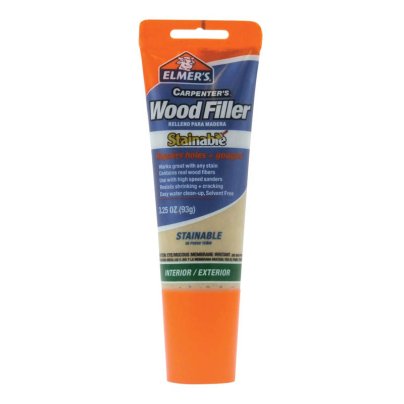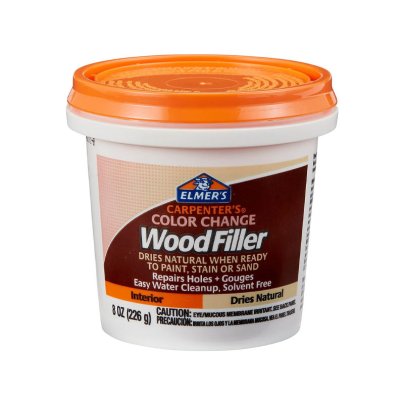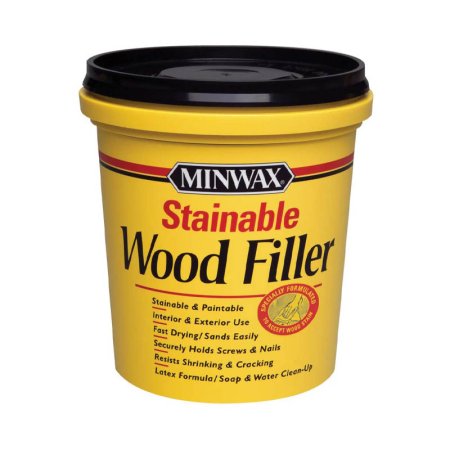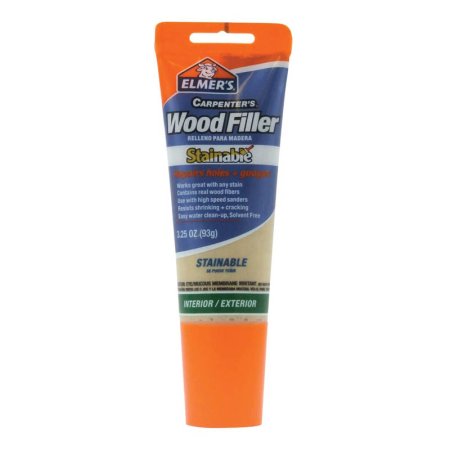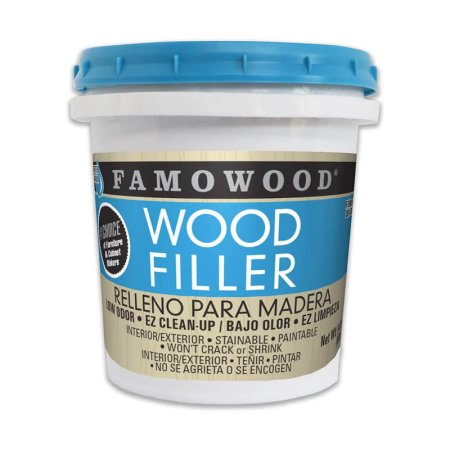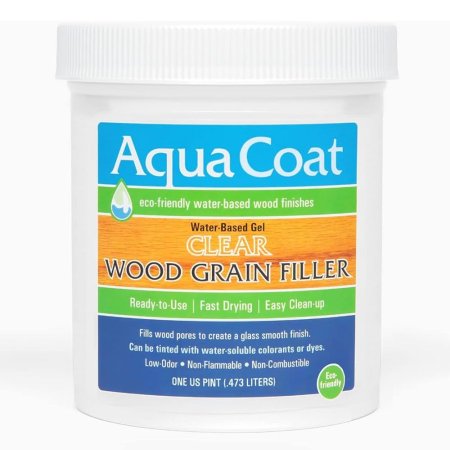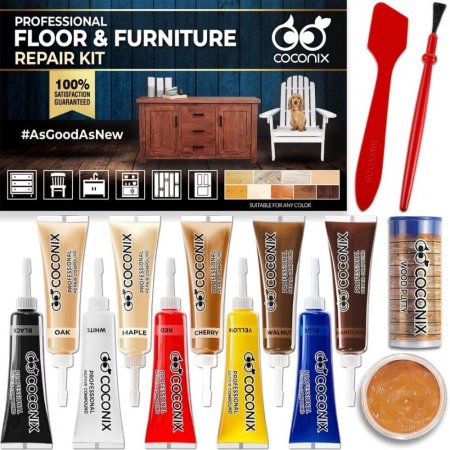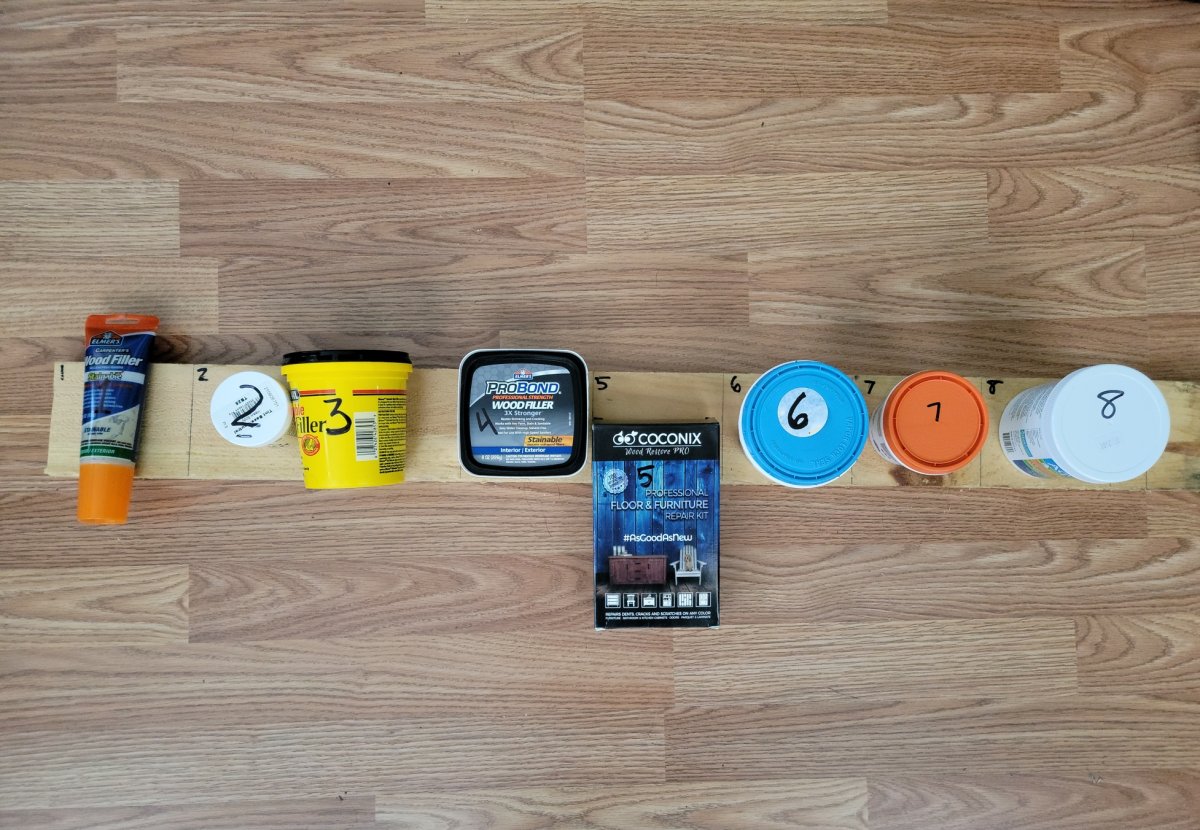
We may earn revenue from the products available on this page and participate in affiliate programs. Learn More ›
Cracks, divots, holes, or rot can crop up on wooden surfaces due to ordinary wear and tear and accidents, or during DIY projects. Fortunately, wood fillers can handle all sorts of repairs, and we tested some of the top wood fillers in several real scenarios to see how well they hid blemishes in wood grain or filled seams and gaps.
Wood fillers come in both water-based and solvent-based formulas. With the wide variety of wood fillers available—each having a unique formulation, usage scenario, and application technique—it can be tricky to pinpoint the right one to use. This guide will explain these practical putties and offer our hands-on testing results to help shoppers know how to choose the best wood filler for their needs.
- BEST OVERALL: Minwax Stainable Wood Filler
- BEST BANG FOR THE BUCK: Elmer’s E887Q Stainable Wood Filler
- BEST FOR BEGINNERS: Elmer’s E913 Carpenter’s Color Change Wood Filler
- UPGRADE PICK: FamoWood 40022126 Latex Wood Filler
- BEST FOR SEALING PORES: Aqua Coat Clear Wood Grain Filler
- BEST FOR HOLES: Goodfilla Heavy-Body Water-Based Wood & Grain Filler
- BEST FOR FURNITURE: Coconix Floor and Furniture Repair Kit
- ALSO CONSIDER: Elmer’s ProBond Wood Filler
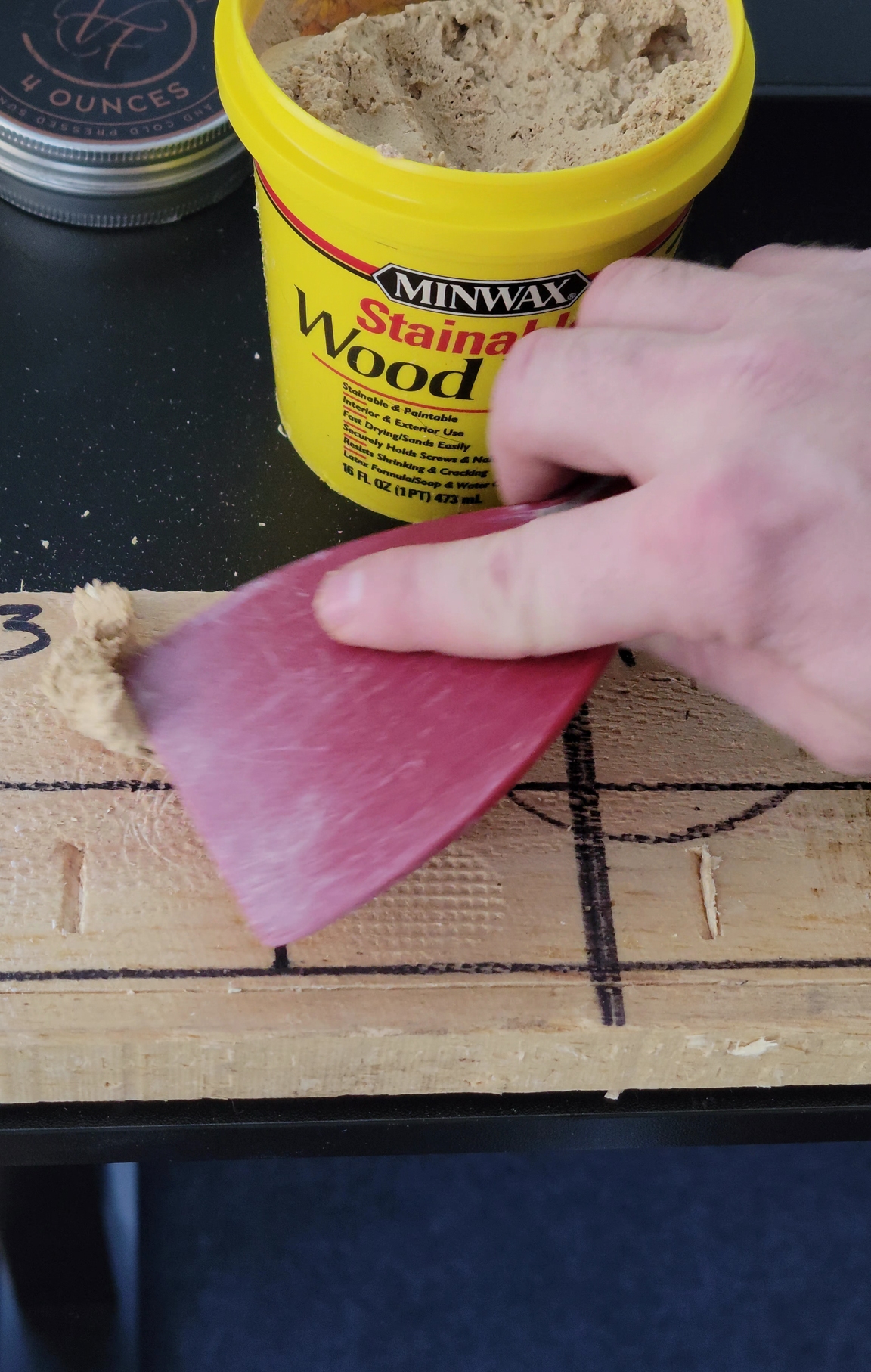
How We Tested the Best Wood Fillers
We consulted with Jonathan Warshaw, a woodworking expert who is the founder and owner of SimpleWoodworker, an educational woodworking site. Warshaw says of wood fillers that “it’s crucial to look for one that is durable, easy to sand, and that can be painted or stained to match the surrounding wood.” He goes on to say that “the versatility of the filler for both interior and exterior projects, as well as its drying time, are also important factors to consider.”
As we tested, we got pretty scientific with this wood filler comparison. First, we found one piece of pine that was large enough to divide into separate sections for the different wood fillers. Then we divided each section into four segments, each with its own scenario:
- A screwdriver point driven into the wood both with and against the grain, meant to simulate the holes left by finish nailers;
- A ¼-inch hole drilled straight through the board;
- A chip of wood taken from the test piece with a chisel; and
- A “Charlie Olson,” or an errant hammer strike shaped like a C or O.
Once each section was properly damaged, we set forth with the wood fillers to fill them in. When they were dry, we sanded the fillers to see how well they cured the damage. The result gave us all the information necessary to suggest the best wood fillers based on their strengths and weaknesses.
Our Top Picks
Each of the following wood fillers was hands-on tested to ensure that our picks were up to snuff. We also organized these options based on features such as formula or intended use.
Best Overall
Minwax Stainable Wood Filler
What We Like
- Spreads easily despite its grainy consistency; suitable for pros as well as first-time users
- Minimal shrinking due to low moisture content in the formula
- Can fill large holes including cracks, gouges, nail holes, knot holes, and more
- No odor is left behind after use
What We Don’t Like
- Large fibers and grain might not seal small pores well
Product Specs
- Type: Water-based
- Indoor or exterior: Both
- Stainable: Yes
This Bob Vila Approved product carries our brand’s highest level of recommendation.

Bob Vila Approved recognizes the household and DIY products that impressed us most in our real-world testing and that exemplify core values of the Bob Vila brand, including craftsmanship, innovation, and value for the dollar. Winners of this designation come recommended by our professional review team and are personally approved by Bob Vila.
When it comes to versatile wood fillers, Minwax Stainable Wood Filler sits at the top of the heap. This water-based wax features a compound made with real wood fibers, leaving behind a strong, durable patch once dry. It’s suitable for indoor and outdoor wood filling, and it can take paint or stain.
During testing, the Minwax Stainable Wood Filler proved to be a joy to work with. Its relatively dry consistency leads to almost no shrinking at all once dry. Also, because of its consistency, we were able to roll small wads of it like putty to fill large holes. Despite its grainy consistency, it was easy to spread with a putty knife and sanded to a smooth texture. The only downside we could find is that the large fibers and grain could be too large to seal off small pores.
Get the Minwax wood filler at Amazon, Lowe’s, or Menards.
Best Bang for the Buck
Elmer’s E887Q Stainable Wood Filler
What We Like
- Incredibly easy to apply; precision applicator is more convenient than some larger containers
- Zero-odor formula is suitable for homes with children, pets, or a lot of traffic
- Does not shrink once it is mixed, lending to convenience and user-friendliness
What We Don’t Like
- Has a tendency to separate or break during shipping
Product Specs
- Type: Water-based
- Indoor or exterior: Both
- Stainable: Yes
Don’t want to lug around a pound of wood filler for a small-scale indoor or outdoor project? This 3.25-ounce, 7-inch tube of water-based stainable wood filler fits right in a pocket or tool box. Suitable for both indoor and outdoor projects, this wood filler also emits zero odor. Once dry, it can accept paint or stain.
During testing, we found the tube of Elmer’s stainable wood filler to have separated into a soupy liquid and a very stiff putty. After mixing (which was difficult to achieve in the tube), it reached a much better consistency and was easy to spread. The holes filled nicely, and despite its wetter consistency, it didn’t shrink much while drying.
Get the Elmer’s E887Q wood filler at Amazon.
Best for Beginners
Elmer’s E913 Carpenter’s Color Change Wood Filler
What We Like
- Goes on purple, then dries to match the wood color
- Leaves an excellent finish; formula is sandable, stainable, and paintable
- Minimal shrinking compared with some of the other options on the market
What We Don’t Like
- Indoor-only use, so it can’t serve as the only wood filler in a shed or shop
- A little thick compared to other viable options
Product Specs
- Type: Water-based
- Indoor or exterior: Indoor
- Stainable: Yes
Novice DIYers who aren’t sure how to tell whether wood filler is ready for sanding will want to consider Elmer’s Carpenter’s Color Change Wood Filler. This interior-only, no-mix, water-based product boasts a patented formula that goes on purple and then turns to a natural color when it’s dry and ready for sanding, staining, and painting. When applied to small repaired areas, the product’s color turns in as little as 15 minutes, and there’s no shrinking or cracking. When applied to deeper voids, the product dries in 2 to 8 hours.
Truth be told, we thought this product was a bit of a gimmick, so we didn’t have high hopes. In reality, it dried quickly without shrinking and sanded to one of the best finishes in the test. It was a little thick during application, but it packed well into the hole in the wood and sanded smoothly. This is definitely the real deal. The only downsides are that it’s a little thick (maybe because of the color additive), and it’s for indoor-only use.
Get the Elmer’s E913 wood filler at Amazon or Walmart.
Upgrade Pick
FamoWood 40022126 Latex Wood Filler
What We Like
- Creates a smooth finish that fills pores on most wood varieties
- Thick but easy to spread; suitable for DIY users as well as professionals
- Dries harder than wood; becomes completely hard in 15 minutes
What We Don’t Like
- Can be frustrating to open the container for the first time
Product Specs
- Type: Water-based
- Indoor or exterior: Both
- Stainable: Yes
For those looking for a premium product, the FamoWood wood filler is a worthy option. It has the versatility and viscosity to handle voids of different sizes, so one tub can handle almost any type of project. The formula is a combination of latex and real wood fiber, and it’s suitable for indoor and outdoor applications. Also, the filler cures in 15 minutes to a harder-than-wood surface. Once dry, it can be sanded, planed, or sawed. It can also be stained or painted.
Here’s the deal: This wood filler is thick. It’s so thick, in fact, that it settled to the lid of the tub and was extremely frustrating to open. However, once we got the tub open, FamoWood did nothing but wow us. Yes, it’s thick, but it was the easiest and smoothest to spread. It also rolls into small wads for plugging holes. The finish left behind was almost entirely shrink-free, and it filled the pores of the test piece entirely.
Get the FamoWood wood filler at Amazon or Walmart.
Best for Sealing Pores
Aqua Coat Clear Wood Grain Filler
What We Like
- Water-based, eco-friendly formula is suitable for the chemical-conscious consumer
- Seals pores very well; suitable for minimizing the absorption of top coats
- Gel consistency leads to easier application relative to other options on the market
What We Don’t Like
- Formula is made for interior use only and is not suitable for outdoor projects
- Shrinks a lot more than some comparable products
Product Specs
- Type: Water-based
- Indoor or exterior: Indoor
- Stainable: Yes
Some wood filler applications don’t require a thick, opaque layer of product. Those who prefer a simple, light, see-through coat that simply seals pores will want to check out Aqua Coat Clear Wood Grain Filler. This wood filler has a thick, milky texture that dries to a clear finish, and since it’s eco-friendly and water-based, cleanup is a breeze.
Admittedly, there are few applications for a wood filler product that doesn’t actually make holes and gouges disappear. However, when it comes to sealing pores, we found Aqua Coat to do an outstanding job. It applied easily and created a smooth, glass-like finish over the wood. Since it’s water-based and eco-friendly, it’s a better choice than polyurethane (for some applications). The downside is that it doesn’t fill holes particularly well, and it does shrink quite a bit. But keep in mind that this product is for sealing pores, not filling holes.
Get the Aqua Coat wood filler at Amazon or Walmart.
Best for Holes
Goodfilla Heavy-Body Water-Based Wood & Grain Filler
What We Like
- Excellent for filling large holes in flooring, windowsills, doors, tables, furniture, and more
- Doesn’t shrink after application, providing peace of mind and ease of use
- Odor-free formula is ideal for homes with heavy traffic, children, or pets
- Easily dilutable and comes in several color options for added convenience
What We Don’t Like
- Not easy to spread out of the tub; there may be a learning curve for new users
Product Specs
- Type: Water-based
- Indoor or exterior: Both
- Stainable: Yes
There are nicks and scrapes, and then there are large holes left from screws, lag bolts, and even carpenter bees. For those big, gaping holes, Goodfilla Water-Based Wood Filler might be the product to choose. This wood filler has a clay-like consistency that doesn’t shrink when dry, and it’s stainable and paintable.
As it came out of the tub, we noticed that Goodfilla didn’t spread easily, so it’s not exceptional for filling scrapes or small spots. We were able to dilute it with a bit of warm water to create a more spreadable consistency, although the clay-like consistency made it very easy to wad into small balls and fill large holes. It’s also odor-free, doesn’t shrink at all, and is suitable for indoor and outdoor use.
Get the Goodfilla wood filler at Amazon or Tractor Supply Co. (walnut color only).
Best for Furniture
Coconix Floor and Furniture Repair Kit
What We Like
- No need to stain after successful color match; comes with everything needed to mix and apply
- Directions are easy to follow to complete repairs of dents, scratches, and cracks
- Comes with all the tools necessary to repair furniture, shelves, baseboards, molding, and more
What We Don’t Like
- Extra-long drying time is not ideal for those who need a quick turnaround
- Will shrink in large repairs
Product Specs
- Type: Water-based
- Indoor or exterior: Interior
- Stainable: No
Small nicks and chips in antique furniture don’t always respond well to traditional wood fillers, making Coconix an attractive option. This repair kit comes with everything necessary to match nearly any color and apply the water-based filler for a top-notch furniture repair. This product is water-based and is only suitable for repairing indoor furniture.
This might not be a traditional wood filler, but there is a lot to like about this kit. First, using the included color guide as a reference, we were able to perfectly match the pine test piece. It doesn’t fill large voids or holes exceptionally well by itself, but it comes with a wood putty that does the trick before coloring over it. The mixing and application were simple as it comes with several base colors, a mixing cup, a spatula, and an application brush. We noticed that this product takes seemingly forever to dry completely (at least a day), and it will shrink; however, it might be the best way to match colors in chipped furniture and millwork.
Get the Coconix repair kit at Amazon.
Also Consider
Elmer’s Probond Wood Filler
What We Like
- Wetter consistency makes it easy to apply on furniture, molding, or baseboards
- Seals pores well despite the grainy texture upon application
- Strong, durable formula suitable for exterior use provides long-term peace of mind
What We Don’t Like
- Shrinks quite a bit after application, which is not ideal for some uses
Product Specs
- Type: Water-based
- Indoor or exterior: Both
- Stainable: Yes
Those looking for professional results at a reasonable price would do well to consider Elmer’s ProBond wood filler. This tub of water-based wood filler features ceramic microsphere technology, which allows the dried wood filler to be tougher and more durable than most other wood fillers. Because it’s suitable for exterior applications (as well as interior), that strength could be a big benefit.
Elmer’s ProBond was easy to apply, thanks to its slightly wet consistency. We felt that the finish it left behind was also very strong. Although the filler was slightly grainy, it seemed to fill the pores nicely on the test piece. However, this product did shrink quite a bit, most likely due to its high moisture content.
Get the Elmer’s ProBond wood filler at Amazon (8 ounces) or Ace Hardware (32 ounces).
Jump to Our Top Picks
Types of Wood Fillers
Wood fillers come in either water- or solvent-based formulas. Either can be used to fill wood voids or pores, but they have several differences.
- Water-based wood fillers are generally a mix containing cellulose, wood fiber, latex, or gypsum. They tend to have a less potent odor, and they emit few, if any, volatile organic compounds (VOCs). Some water-based wood fillers are more versatile than their solvent-based counterparts because they can be readily diluted with water and used in projects requiring thinner filler. Water-based fillers typically dry in about 15 minutes, and cleanup requires only soap and water.
- Solvent-based fillers tend to consist of vinyl or epoxy. They have a higher VOC content and are correspondingly smellier. Solvent-based wood fillers take about an hour to dry, and cleaning up after use calls for acetone or turpentine. Cost-wise, solvent-based fillers are pricier than water-based fillers because they’re more resistant to water, humidity, extreme heat and cold, and rot, making them best suited to exterior wood projects and applications.
What to Consider When Choosing a Wood Filler
Now that you have read about some of the best products on the market, here are some important features to consider when selecting the best option for a given project or intended use.
Task
Wood fillers typically handle one or more specific tasks. Some are suitable for filling voids such as divots, holes, or gouges in all wood species. Others are for filling pores in open-grain woods with large pores visible to the naked eye, such as oak or elm, to smooth their naturally coarse texture. (As the filler inundates the pores, it levels any unevenness to achieve a finish particularly desirable on furniture.) The most versatile fillers can fill either voids or pores.
Consistency
Wood fillers can have thick (putty-like) or thin (pancake batter–like) consistencies. Thicker fillers are primarily for filling voids, while thinner fillers mainly fill pores in open-grain woods. It’s important to choose the right consistency for your project, as thicker fillers contain large particles that don’t readily fit into the pores of open-grain woods, and thinner fillers generally lack the body to adequately fill voids. (Tip: In a pinch, some thicker fillers can be thinned with water to fill pores.)
Color
The most common fillers come in white or wood-inspired shades; clear versions for filling pores are also available. If you don’t plan to ultimately stain or paint the piece, opt for a filler in a shade that either closely matches or contrasts with the original wood color, depending on whether you want to play down or play up the filler color. If you do intend to coat the cured filler with stain or paint, be sure to pick a stainable or paintable product, either in white or in a shade that’s lighter than the stain or paint you’ll use.
Application Environment
Fillers are generally for “interior-only” or “interior/exterior” use. This serves as an indication of how well the filler will hold up in the stated environment during application, while wet, and after it has dried.
- Interior-only fillers can be safely applied indoors to wooden pieces that will stay indoors, such as a coffee table. If that same product is applied outdoors or to a piece that will live outdoors, such as a patio table, the filler will be more likely to freeze or harden while wet from exposure to extreme cold or heat, or it may crack or shrink over time once dry.
- Interior/exterior fillers can be applied in either environment and to wood pieces that will live indoors or out since they can withstand extreme weather without hardening during application or cracking/shrinking once dry. Water-based interior/exterior fillers are more versatile because they’re durable enough for outdoor projects yet emit virtually no odor while wet. While solvent-based interior/exterior fillers are safe to apply in both environments, it’s best to use them for heavy-duty outdoor projects (e.g., filling gouges or replacing rotted decking), where their highly weather-resistant solvents can handily defend against the elements and the fumes they emit while wet will quickly dissipate in the air.
Packaging
Wood fillers are packaged in tubs, squeeze tubes, and sticks. Those in tubs are either no-mix and can be applied with a putty knife or spreader, while two-part fillers must be mixed before application. For tube fillers, you need only squeeze out a scant amount to fill voids or pores, while with stick fillers, simply rip off a small chunk and apply by hand. Tubs, which hold the most product, tend to be most economical and are suited to larger projects, while sticks are the least cost-effective and best used to repair scratches and cracks.
FAQs
Even with all that background on the best wood fillers, you might have a few additional questions. This section aims to fill you in on the most frequently asked questions about the best wood fillers. Be sure to check for an answer to your question listed below.
Wood filler is designed to be stained or painted, and it goes on before the finishing coats. Wood putty is primarily for after finishing, and it comes in predetermined colors. Be advised that wood filler is designed to be durable enough for exterior use, while wood putty is suitable for indoor projects.
It depends on the product, but some wood fillers are suitable for use both indoors and out. Typically, epoxy-based wood filler is durable enough for outdoor applications. Just be sure that the surface is stained and sealed ahead of any inclement weather.
Almost all wood fillers are paintable; however, some are also suitable for staining. Be advised that some fillers may not work effectively with paint and may require a primer for an even, long-lasting look. Additionally, wood filler should be allowed to dry completely before any paint is applied (users will want to consider waiting up to 24 hours).
Meet the Tester
Tom Scalisi is a full-time DIY and construction writer for many of the largest websites in the industry, including BobVila.com, This Old House, Family Handyman, and Forbes as well as his own pest control blog. He spent years working in the trades and industrial building maintenance and has had plenty of experience using wood fillers.
Additional research provided by Manasa Reddigari.

